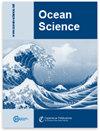长期涡流调节影响波弗特环流中晕线的经向不对称性
IF 3.3
3区 地球科学
Q2 METEOROLOGY & ATMOSPHERIC SCIENCES
引用次数: 0
摘要
摘要随着北极海冰的消退,风的作用发生了变化,在此背景下,波弗特环流(BG)区域的中尺度过程发生了明显的变化,对海洋传输和能量级联的作用越来越重要,这些变化使海洋分层进入了一个新的状态。本文基于系泊观测数据(2003-2018 年)、测高数据(1993-2019 年)和再分析数据(1980-2020 年),研究了加拿大盆地(CB)中部和楚科奇-波弗特大陆坡漩涡的数量和强度变化。本文展示了代表上层分层调整的 BG 卤线的变化,以分析在中尺度变化过程中如何发生变化。根据多个数据集,我们发现在过去近 20 年中,中央涡旋南部的卤线深度加深了 40 米,而北部则加深了 70 米。在中央涡旋周围,卤线的不对称性在 2014 年后有所减弱,南部大陆坡的等深线更陡更深。与此同时,从北大西洋南缘到深海平原的上层漩涡活动增强。此外,由于两侧(距离中央涡旋至少 120 千米)的卤跃层结构达到了几乎相同的稳定状态,漩涡侧向通量的汇聚也有所增加。这说明,通过漩涡通量的长期动态漩涡调制,促进了淡水的再分配,影响了 BG 卤线的经向不对称性。我们的研究结果有助于更好地理解涡旋调节过程及其对卤线结构的影响。本文章由计算机程序翻译,如有差异,请以英文原文为准。
Long-term eddy modulation affects the meridional asymmetry of the halocline in the Beaufort Gyre
Abstract. Against the background of wind-forcing change along with Arctic sea ice retreat, the mesoscale processes undergoing distinct variation in the Beaufort Gyre (BG) region are increasingly important to oceanic transport and energy cascades, and these changes subsequently put oceanic stratification into a new state. Here, the varying number and strength of eddies in the central Canada Basin (CB) and Chukchi–Beaufort continental slope are obtained based on mooring observations (2003–2018), altimetry measurements (1993–2019), and reanalysis data (1980–2020). In this paper, the variability in the BG halocline, representing the adjustment of stratification in the upper layer, is shown in order to analyse how variability occurs under changing mesoscale processes. We find that over almost the last 2 decades the halocline depth has deepened by ∼ 40 m in the south of the central gyre, while that in the north has deepened by ∼ 70 m according to multiple datasets. Surrounding the central gyre, the asymmetry of the halocline, with much steeper and deeper isopycnals over the southern continental slope, reduced after 2014. In the meantime, eddy activities in the upper layer from the southern margin of the BG to the abyssal plain have been enhanced. Moreover, the convergence of the eddy lateral flux has increased as the halocline structures on either side, which is at least 120 km from the central gyre, have reached a nearly identical and stable regime. It has been clarified that long-term dynamic eddy modulation through eddy fluxes, facilitating the freshwater redistribution, affects the meridional asymmetry of the BG halocline. Our results provide a better understanding of the eddy modulation processes and their influence on the halocline structure.
求助全文
通过发布文献求助,成功后即可免费获取论文全文。
去求助
来源期刊

Ocean Science
地学-海洋学
CiteScore
5.90
自引率
6.20%
发文量
78
审稿时长
6-12 weeks
期刊介绍:
Ocean Science (OS) is a not-for-profit international open-access scientific journal dedicated to the publication and discussion of research articles, short communications, and review papers on all aspects of ocean science: experimental, theoretical, and laboratory. The primary objective is to publish a very high-quality scientific journal with free Internet-based access for researchers and other interested people throughout the world.
Electronic submission of articles is used to keep publication costs to a minimum. The costs will be covered by a moderate per-page charge paid by the authors. The peer-review process also makes use of the Internet. It includes an 8-week online discussion period with the original submitted manuscript and all comments. If accepted, the final revised paper will be published online.
Ocean Science covers the following fields: ocean physics (i.e. ocean structure, circulation, tides, and internal waves); ocean chemistry; biological oceanography; air–sea interactions; ocean models – physical, chemical, biological, and biochemical; coastal and shelf edge processes; paleooceanography.
 求助内容:
求助内容: 应助结果提醒方式:
应助结果提醒方式:


